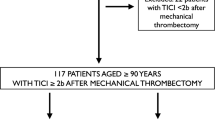Abstract
We aimed to develop a hemostatic device with physiological evidence that allows ambulation soon after atrial fibrillation (AF) ablation. We measured right femoral vein pressure in 57 participants to clarify why groin post-venipuncture rebleeding often occurs during the transition from supine to sitting under compression bandage application and found that it increased more than threefold when raising the upper body (8.6 ± 4.1 to 27.6 ± 6.9 mmHg; P < 0.001). Based on that data, we created a novel hemostatic belt. Its capability test including 25 participants demonstrated that the belt gave much higher compression pressures on the right groin while sitting than the compression bandage (59.5 ± 14.9 vs. 8.1 ± 4 mmHg; P < 0.001), achieving pressures above the maximum femoral vein pressure in 92% of participants. A randomized trial comparing the belt with compression bandage in 74 AF patients demonstrated that the belt reduced time to ambulation without any rebleeding (340 [92.5–360] vs. 360 [360–360] min; P < 0.001) and satisfied more patients.
Graphical abstract

The novel hemostatic belt provided a much higher compression pressure on the right groin during the sitting position than the conventional compression bandage, achieving a pressure above the maximum femoral vein pressure in 92% of the participants.




Similar content being viewed by others
Change history
29 August 2023
A Correction to this paper has been published: https://doi.org/10.1007/s12265-023-10430-5
References
Calkins H, Hindricks G, Cappato R, et al. 2017 HRS/EHRA/ECAS/APHRS/SOLAECE expert consensus statement on catheter and surgical ablation of atrial fibrillation. Heart Rhythm. 2017;14:e275–444.
Sairaku A, Nakano Y, Oda N, et al. Rapid hemostasis at the femoral venous access site using a novel hemostatic pad containing kaolin after atrial fibrillation ablation. J Interv Card Electrophysiol. 2011;31:157–64.
Kawabata T, Sugama J. Relationship between mattress internal air pressure and interface pressure distribution in the lateral position. Int Wound J. 2022;19:2115–23.
Sairaku A, Morishima N, Matsumura H, et al. Intra-procedural anticoagulation and post-procedural hemoglobin fall in atrial fibrillation ablation with minimally interrupted direct oral anticoagulants: comparisons across 4 drugs. J Interv Card Electrophysiol. 2021;61:551–7.
Nin T, Sairaku A, Yoshida Y, Kamiya H, et al. A randomized controlled trial of dabigatran versus warfarin for periablation anticoagulation in patients undergoing ablation of atrial fibrillation. Pacing Clin Electrophysiol. 2013;36:172–9.
Hallway A, Vu J, Lee J, et al. Patient satisfaction and pain control using an opioid-sparing postoperative pathway. J Am Coll Surg. 2019;229:316–22.
Corder GW, Foreman DI. Nonparametric statistics for non-statisticians: a step-by-step approach. Wiley & Sons; 2009.
Strandness DE, Summer DS. Hemodynamics for surgeons. Grune & Stratton Inc; 1975. p. 120–57.
Natale A, Mohanty S, Liu PY, et al. Venous vascular closure system versus manual compression following multiple access electrophysiology procedures: the AMBULATE trial. JACC Clin Electrophysiol. 2020;6:111–24.
Mohammed M, Ramirez R, Steinhaus DA, et al. Comparative outcomes of vascular access closure methods following atrial fibrillation/flutter catheter ablation: insights from VAscular Closure for Cardiac Ablation Registry. J Interv Card Electrophysiol. 2022;64:301–10.
Aytemir K, Canpolat U, Yorgun H, et al. Usefulness of 'figure-of-eight' suture to achieve haemostasis after removal of 15-French calibre femoral venous sheath in patients undergoing cryoablation. Europace. 2016;18:1545–50.
Funding
This work was supported by JMS Co., Ltd (Hiroshima, Japan).
Author information
Authors and Affiliations
Corresponding author
Ethics declarations
Ethics approval
Not applicable.
Conflict of interest
The authors declare no competing interests.
Additional information
Editor-in-Chief Enrique Lara-Pezzi oversaw the review of this article
Publisher’s Note
Springer Nature remains neutral with regard to jurisdictional claims in published maps and institutional affiliations.
The original version of this article was revised: In the second sentence under the heading Statistical analysis in the article as originally published, “means+SDs” should have read “means±SDs”.
Supplementary information
Cine radiographs of the right groin during knee lifts in a volunteer. The head of the hemostatic belt (a square X-ray image) is placed on a doughnut-shaped coin firmly attached to the assumed venipuncture site with adhesive tape. Note that the head is firmly immobilized on the coin even with dynamic hip joint movements. Frontal (A) and lateral (B) images are shown (MP4 7998 kb)
(MP4 7790 kb)
Rights and permissions
Springer Nature or its licensor (e.g. a society or other partner) holds exclusive rights to this article under a publishing agreement with the author(s) or other rightsholder(s); author self-archiving of the accepted manuscript version of this article is solely governed by the terms of such publishing agreement and applicable law.
About this article
Cite this article
Sairaku, A., Hashimoto, K. & Nakano, Y. A Novel Hemostatic Belt Allowing Ambulation Soon After Atrial Fibrillation Ablation. J. of Cardiovasc. Trans. Res. 16, 1439–1446 (2023). https://doi.org/10.1007/s12265-023-10417-2
Received:
Accepted:
Published:
Issue Date:
DOI: https://doi.org/10.1007/s12265-023-10417-2




